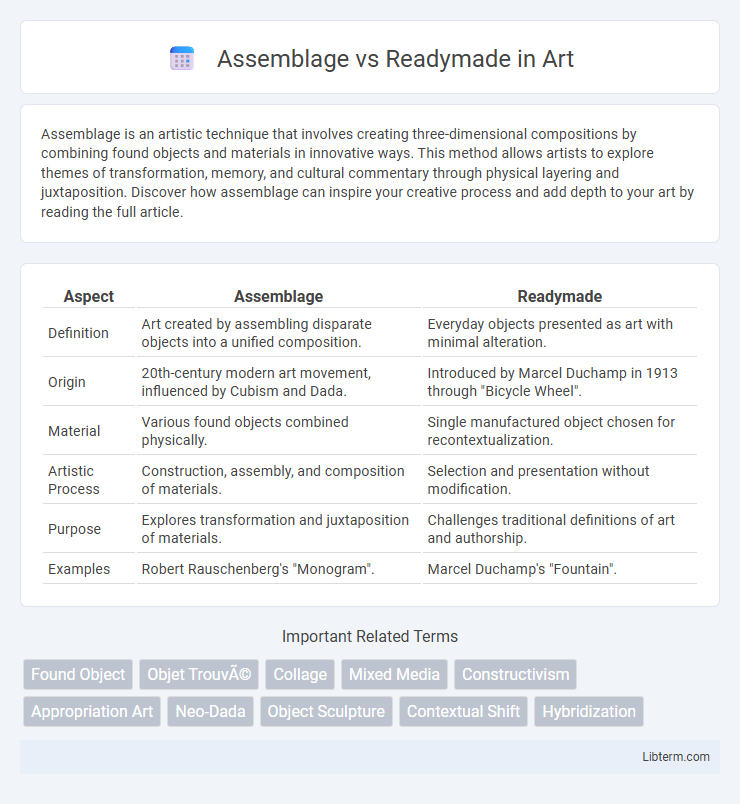Assemblage is an artistic technique that involves creating three-dimensional compositions by combining found objects and materials in innovative ways. This method allows artists to explore themes of transformation, memory, and cultural commentary through physical layering and juxtaposition. Discover how assemblage can inspire your creative process and add depth to your art by reading the full article.
Table of Comparison
| Aspect | Assemblage | Readymade |
|---|---|---|
| Definition | Art created by assembling disparate objects into a unified composition. | Everyday objects presented as art with minimal alteration. |
| Origin | 20th-century modern art movement, influenced by Cubism and Dada. | Introduced by Marcel Duchamp in 1913 through "Bicycle Wheel". |
| Material | Various found objects combined physically. | Single manufactured object chosen for recontextualization. |
| Artistic Process | Construction, assembly, and composition of materials. | Selection and presentation without modification. |
| Purpose | Explores transformation and juxtaposition of materials. | Challenges traditional definitions of art and authorship. |
| Examples | Robert Rauschenberg's "Monogram". | Marcel Duchamp's "Fountain". |
Defining Assemblage: Concept and History
Assemblage refers to an art form that involves creating three-dimensional compositions by combining found objects, often emphasizing the juxtaposition of disparate elements to convey deeper meanings. Originating in the early 20th century, assemblage was popularized by artists like Pablo Picasso and Marcel Duchamp, who challenged traditional notions of sculpture and artistic creation. This art practice diverges from readymades by transforming objects into new coordinated structures rather than presenting single found items as standalone artworks.
Understanding Readymade: Origins and Meaning
Readymades, pioneered by Marcel Duchamp in the early 20th century, are ordinary manufactured objects designated as art by the artist's selection and context, challenging traditional notions of artistic creation. This concept originated with Duchamp's iconic piece "Fountain" (1917), a urinal signed "R. Mutt," which redefined the boundaries of art by emphasizing idea over craftsmanship. Unlike assemblage, which involves combining multiple elements into a new composition, readymades remain unaltered objects presented to provoke thought about art's nature and originality.
Key Differences Between Assemblage and Readymade
Assemblage involves creating artworks by combining multiple found objects into a cohesive piece, emphasizing the relationship between elements and often three-dimensional construction. Readymade refers to a single, pre-existing manufactured object presented as art with minimal alteration, highlighting the artist's selection rather than transformation. The key difference lies in assemblage's additive and compositional process versus readymade's reliance on contextual redefinition of an unmodified object.
Pioneers of Assemblage Art
Assemblage art pioneers such as Pablo Picasso and Marcel Duchamp transformed everyday objects into innovative sculptures, contrasting with readymades that presented single, unaltered items. Robert Rauschenberg expanded assemblage by combining diverse materials and found objects into dynamic compositions, influencing contemporary mixed-media art. This approach emphasizes the creative recontextualization of multiple elements, differentiating it fundamentally from the conceptual simplicity of readymades.
Marcel Duchamp and the Birth of the Readymade
Marcel Duchamp revolutionized modern art with the introduction of the Readymade, a concept where ordinary manufactured objects were elevated to art status by the artist's selection alone. Unlike assemblage, which involves combining various materials and objects into a new composition, Duchamp's Readymades emphasized the idea and context over physical alteration, challenging traditional notions of craftsmanship. This innovative approach marked the birth of conceptual art and significantly influenced 20th-century artistic movements.
Materials and Techniques in Assemblage vs Readymade
Assemblage art incorporates diverse materials often scavenged from everyday objects, combining them through techniques like collage, welding, or fastening to create new, dynamic compositions. Readymade art emphasizes the selection and recontextualization of pre-existing manufactured objects without alteration, relying on the artist's choice and placement to challenge traditional art definitions. Assemblage integrates variety in texture and form through manual construction, while readymades focus on conceptual impact by presenting ordinary items as art.
Artistic Intent: Narrative vs Objecthood
Assemblage emphasizes artistic intent by creating a narrative through the combination of disparate objects, conveying complex meanings and personal stories. Readymades focus on objecthood, where the artwork's significance arises from the selection and context rather than transformation or narrative. This contrast highlights how assemblage prioritizes storytelling and conceptual depth, whereas readymades challenge traditional definitions of art by emphasizing the inherent value of ordinary objects.
Cultural Impact of Assemblage and Readymade Art
Assemblage art, characterized by the combination of found objects into three-dimensional compositions, challenged traditional art boundaries and fueled cultural dialogues about consumerism and identity in the 20th century. Readymade art, popularized by Marcel Duchamp, disrupted notions of artistic originality by elevating everyday manufactured objects to the status of art, provoking debates on authorship and the role of art institutions. Both movements significantly influenced contemporary art practices, inspiring cultural critiques and expanding definitions of creativity across global art scenes.
Notable Examples in Contemporary Art
Notable examples of assemblage in contemporary art include Robert Rauschenberg's "Canyon," which combines found objects and images to create layered narratives, and Louise Nevelson's monochromatic wooden sculptures that integrate discarded materials into cohesive forms. In contrast, Marcel Duchamp's pioneering readymade "Fountain," a urinal signed "R. Mutt," challenges traditional notions of art by presenting ordinary manufactured objects as art without alteration. These works highlight the assemblage's emphasis on combining diverse elements versus the readymade's focus on the conceptual selection of pre-existing objects.
Assemblage and Readymade in Today’s Creative Practices
Assemblage in today's creative practices involves assembling diverse found objects into new, cohesive artworks that emphasize materiality and narrative, fostering innovation in mixed media and sculpture. Readymades challenge traditional notions of art by presenting everyday manufactured items as art, pushing boundaries in conceptual creativity and questioning originality. Contemporary artists blend assemblage and readymade techniques to explore identity, consumer culture, and environmental concerns, reflecting dynamic dialogues within modern visual art.
Assemblage Infographic

 libterm.com
libterm.com